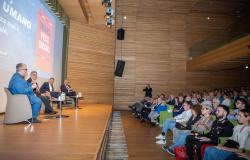Pilade and Oreste, two young people from Lombardy, 28 and 25 years old in the autumn of 1860: unfortunately Italy does not remember, does not recognize, does not celebrate. In fact, the historical essay by the professor seems like a book from another era. Umberto BardiniMantuan researcher of military and nineteenth-century history, Among Garibaldi’s Thousand. The exploits of the Bronzetti brothers (Udine, August 2023, series “Military history of the Risorgimento”, 112 pages).
Edizioni Gaspari have the great merit of having proposed it recently, with black and white illustrations in two inserts and color maps created by Arianna Bardini.
Significantly, the essayist and scholar of the Risorgimento Marco Scardigli quotes in the preface a comic by Sergio Toppi in the “Corriere dei Piccoli” of 5 October 1969, The 300 of Castelmorronebased on a story by Mino Milani.
How many children were excited by the courage of Bronzetti’s Garibaldi, who resisted 5,000 Bourbons for hours. How much pathos in those images, moreover, without emotions the story is dry, observes Scardigli, who finds many of them in Bardini’s work: fights, heroic gestures, alongside disappointments, suffering, losses and renunciations.
Many heroes of the Italian Risorgimento, in the highest sense”and the Bronzetti are among them”, from Mantua from a family originally from the Habsburg Trentino area. Together with Narciso, born in 1821, Pilade (1832) and Oreste (1835), Garibaldi volunteers and officers of the southern army in red shirts in 1860, particularly distinguished themselves.
Today’s Italians have forgotten them and from one part of the South there arises a revisionist journalism of the Risorgimento, nostalgic for the Bourbons and anti-Savoy, which despises them as “adventurers”.
The worst is that those who demolish – on non-historical, only propagandistic grounds, anyway – the moral and military stature of authentic patriots are the same ones who transfigure the anti-unity brigands, who at most we could consider rebels, insurgents, as romantic heroes. A falsification, it is difficult to ennoble, even as guerrillas, murderous bandits, heirs of the brigandage endemic for centuries in the South, irreducible even under the Bourbons.
To place them in the very unepic-ethical role of “raiders” he was, then and not now, someone who not only fought together with them, but deluded himself that they believed in a common cause, soon having to regret his mistake, before being shot in Tagliacozzo, on 8 December 1861 Josè Borjes, a Spanish Carlist general, had been sent to Calabria by the Bourbon circles to take over the military direction of the uprisings, insurrections and guerrilla actions, which the loyalists and the reactionary clergy fomented against the newly established Italian authorities. He fought among Carmine Crocco’s gangs, but realized that he could not organize a real civil war for the throne and the altar, leading organized and disciplined masses of armed men, with the aim of permanently conquering large centers and territories. He noted that “armed peasants could only wage guerrilla warfare and torment the landowners’ properties” (source: Enciclopedia Treccani). After the capture of Power failed, he attempted to enter the Papal States from Marsica, but was surrounded by Italian troops.
Before the post-unification brigandage, the difference between the uncertain motivations of the Bourbon soldiers and the noble ones of Garibaldi’s volunteers, mostly republicans, stood out precisely in the Battle of Volturno, the crucial crux of Italian unification during the Risorgimento. On October 2, 1860, courage, patriotic ideals and dedication to the cause prevailed over the strength of many. Double versus half that day in the Caserta area. And up there, in Castel Morrone, the Thermopylae of Italy, Pilade Bronzetti’s three hundred distinguished themselves, opposing Neapolitan troops twenty times superior.
With the advance of the Bourbon columns from Gaeta towards Caserta, over 40 thousand men from the Kingdom of the Two Sicilies clashed against just over 20 thousand Garibaldians.
And on top of Castel Morrone, 292 Lombard Bersaglieri, under the command of Major Bronzetti, faced the assault of 5 thousand opponents.
That day, a few thwarted the offensive of many and won, thanks to the five hour delay imposed up there, on the castle at 492 meters, to the enemy’s outflanking movement towards Maddaloni and the road to Naples. Once the ammunition ran out, the Lombards threw stones at the enemies, before raising the white flag. It had already been exposed when Pilade fell, bayoneted and still fighting furiously.
If in the South neo-Bourbon revisionism has visibility rather than credit, it clashes with history, as well as with historiography (read Galli Della Loggia).
Was Francis II’s army on the side of reason? Was he defending a flourishing, advanced Kingdom?
What better occasion, therefore, than a clash with the advantage of weapons and armed men, to demonstrate moral, motivational, military superiority over “adventurers” of Garibaldi, if these were so inferior, even ethically?
All denied that day in Caserta Vecchia, at the Ponti della Valle, at Castel Morrone, wherever Garibaldi’s people resisted or retreated to positions they still maintained.
After a century and a half, opinions can also try to overturn the truth and history, but never change the reality of the facts of 1860: young republicans defeated a professional army twice as strong and forced him to shut himself up in Gaeta, even before the arrival of the Piedmontese, still marching in Abruzzo.
Scardigli’s conclusion as a historian: the merit of the book is to restore greatness to those who paid the highest price for the love of Italy and for a unified objective.
“Seal to an extraordinary story made of ideals, sacrifices, generosity and, above all, coherence”.






